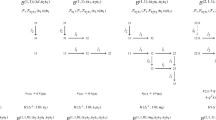Let σ 1 and σ 2 be commuting involutions of a semisimple algebraic group G. This yields a \( {{\mathbb{Z}}_2}\times {{\mathbb{Z}}_2} \)-grading of \( \mathfrak{g} \) = Lie(G), \( \mathfrak{g}={\oplus_{i,j=0,1 }}{{\mathfrak{g}}_{ij }} \), and we study invariant-theoretic aspects of this decomposition. Let \( \mathfrak{g}\left\langle {{\sigma_1}} \right\rangle \) be the \( {{\mathbb{Z}}_2} \)-contraction of \( \mathfrak{g} \) determined by σ 1. Then both σ 2 and σ 3 := σ 1 σ 2 remain involutions of the non-reductive Lie algebra \( \mathfrak{g}\left\langle {{\sigma_1}} \right\rangle \). The isotropy representations related to \( \left( {\mathfrak{g}\left\langle {{\sigma_1}} \right\rangle, {\sigma_2}} \right) \) and \( \left( {\mathfrak{g}\left\langle {{\sigma_1}} \right\rangle, {\sigma_3}} \right) \) are degenerations of the isotropy representations related to \( \left( {\mathfrak{g},{\sigma_2}} \right) \) and \( \left( {\mathfrak{g},{\sigma_3}} \right) \), respectively. These degenerated isotropy representations retain many good properties. For instance, they always have a generic stabiliser and their algebras of invariants are often polynomial. We also develop some theory on Cartan subspaces for various \( {{\mathbb{Z}}_2} \)-gradings associated with the \( {{\mathbb{Z}}_2}\times {{\mathbb{Z}}_2} \)-grading of \( \mathfrak{g} \) and study the special case in which σ 1 and σ 2 are conjugate.
Similar content being viewed by others
References
Л. B. Антонян, O классификацию однородных элементы \( {{\mathbb{Z}}_2} \) -градуированных полупростых алгебр Ли, Вестник Моск. Ун-та, Cер. 1 Матем Мех. (1982), no. 2, 29–34. Engl. transl.: L. V. Antonyan, On the classification of homogeneous elements of \( {{\mathbb{Z}}_2} \)-graded semisimple Lie algebras, Moscow Univ. Math. Bull. 37 (1982), no. 2, 36–43.
A. Bialynicki-Birula, On homogeneous affine spaces of linear algebraic groups, Amer. J. Math. 85 (1963), 577–582.
M. Bulois, Sheets of symmetric Lie algebras and Slodowy slices, J. Lie Theory 21 (2011), 1–54.
M. Duo, Opérateurs différentiels invariants sur un espace symétrique, C. R. Acad. Sci., Paris, Sér. A−B 289 (1979), no. 2, A135−A137.
F. Gonzalez, S. Helgason, Invariant differential operators on Grassmann manifolds, Adv. Math. 60 (1986), 81–91.
S. Helgason, Differential Geometry, Lie Groups, and Symmetric Spaces, Academic Press, New York, 1978.
A. Helminck, G. Schwarz, Orbits and invariants associated with a pair of commuting involutions, Duke Math. J. 106 (2001), 237–279.
A. Helminck, G. Schwarz, Smoothness of quotients associated with a pair of commuting involutions, Canad. J. Math. 56 (2004), 945–962.
A. Kollross, Exceptional \( {{\mathbb{Z}}_2}\times {{\mathbb{Z}}_2} \)-symmetric spaces, Pacific J. Math. 242 (2009), no. 1, 113–130.
B. Kostant, Lie group representations on polynomial rings, Amer. J. Math. 85 (1963), 327–404.
B. Kostant, S. Rallis, Orbits and representations associated with symmetric spaces, Amer. J. Math. 93 (1971), 753–809.
D. Luna, Sur les orbites fermées des groupes algébriques réductifs, Invent. Math. 16 (1972), 1–5.
T. Matsuki, Double coset decompositions of reductive Lie groups arising from two involutions, J. Algebra 197 (1997), 49–91.
A. L. Onishchik, E. B. Vinberg, Lie Groups and Algebraic Groups, Springer-Verlag, Berlin, 1990.
D. I. Panyushev, On spherical nilpotent orbits and beyond, Ann. Inst. Fourier 49 (1999), 1453–1476.
D. I. Panyushev, On invariant theory of θ-groups, J. Algebra 283 (2005), 655–670.
D. I. Panyushev, Semi-direct products of Lie algebras and their invariants, Publ. R.I.M.S. 43 (2007), no. 4, 1199–1257.
D. I. Panyushev, On the coadjoint representation of \( {{\mathbb{Z}}_2} \)-contractions of reductive Lie algebras, Adv. Math. 213 (2007), 380–404.
Э. Б. Винберг, В. Л. Попов, Теория инвариантов, Итоги науки и техн., Соврем. пробл. матем., Фундам. направл., т. 55, Алгебраическaя геометрия−4, ВИНИТИ, М., 1989, cтр. 137–314. Engl. transl.: V. L. Popov, E. B. Vinberg, Invariant Theory, in: Algebraic Geometry, IV, Encyclopaedia of Mathematical Sciences, Vol. 55, Springer-Verlag, Berlin, 1994, pp. 123–284.
R. W. Richardson, Orbits, invariants, and representations associated to involutions of reductive groups, Invent. Math. 66 (1982), no. 2, 287–312.
R. W. Richardson, Normality of G-stable subvarieties of a semisimple Lie algebra, in: Algebraic Groups’, Lecture Notes Mathematics, Vol. 1271, Springer, Berlin, 1987, pp. 243–264.
R. W. Richardson, Derivatives of invariant polynomials on a semisimple Lie algebra, in: Miniconference on Harmonic Analysis and Operator Algebras (Canberra, 1987), Proc. Centre Math. Anal. Austral. Nat. Univ., Vol. 15, Austral. Nat. Univ., Canberra, 1987, pp. 228–241.
M. Rosenlicht, On quotient varieties and the affine embedding of certain homogeneous spaces, Trans. Amer. Math. Soc. 101 (1961), 211–223.
G. Schwarz, C. Zhu, Invariant differential operators on symplectic Grassmann manifolds, Manuscr. Math. 82 (1994), no. 2, 191–206.
W. Smoke, Commutativity of the invariant differential operators on a symmetric space, Proc. Amer. Math. Soc. 19 (1968), 222–224.
T. A. Springer, Regular elements of finite reection groups, Invent. Math. 25 (1974), 159–198.
M. Vergne, Instantons et correspondance de Kostant−Sekiguchi, C. R. Acad. Sci., Paris, Sér. I 320 (1995), no. 8, 901–906.
E. B. Vinberg, Short SO3-structures on simple Lie algebras and associated quasiel-liptic planes, in: E. Vinberg ed., Lie Groups and Invariant Theory, American Mathematical Society Translations, Series 2, Vol. 213, 2005, American Mathematical Society, Providence, RI, pp. 243–270.
O. S. Yakimova, One-parameter contractions of Lie-Poisson brackets, J. Europ. Math. Soc. (2013), to appear, arXiv:1202.3009.
Author information
Authors and Affiliations
Corresponding author
Rights and permissions
About this article
Cite this article
Panyushev, D.I. Commuting involutions and degenerations of isotropy representations. Transformation Groups 18, 507–537 (2013). https://doi.org/10.1007/s00031-013-9224-y
Received:
Accepted:
Published:
Issue Date:
DOI: https://doi.org/10.1007/s00031-013-9224-y




